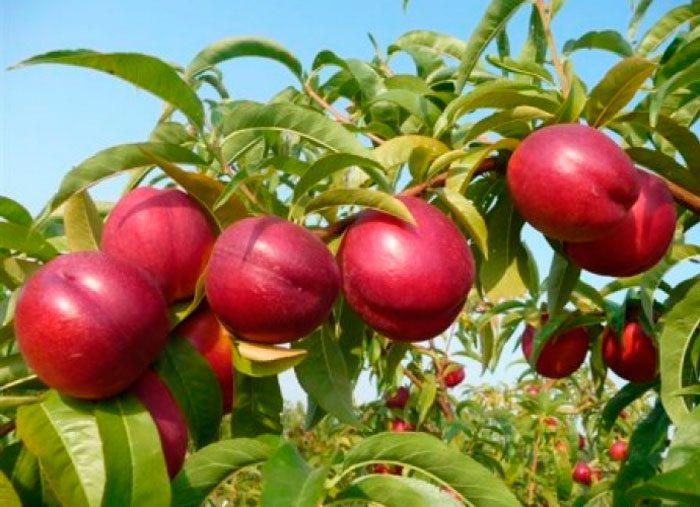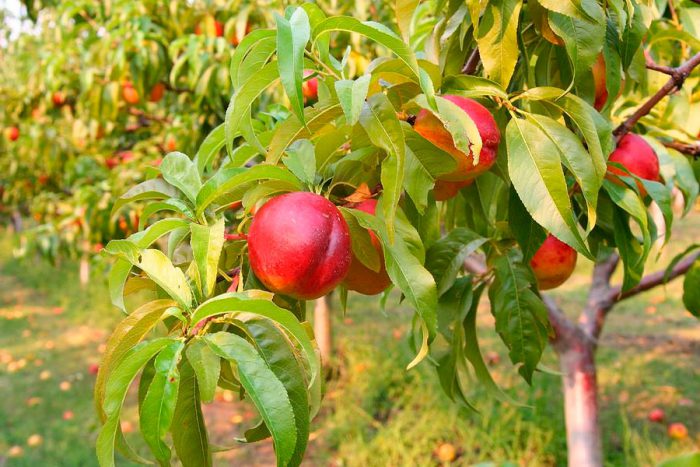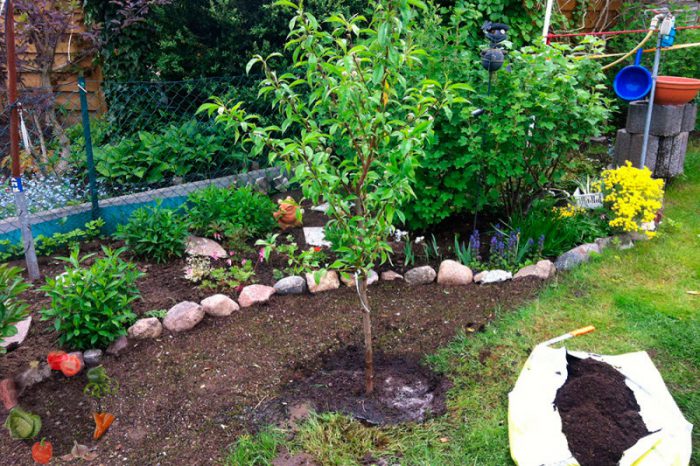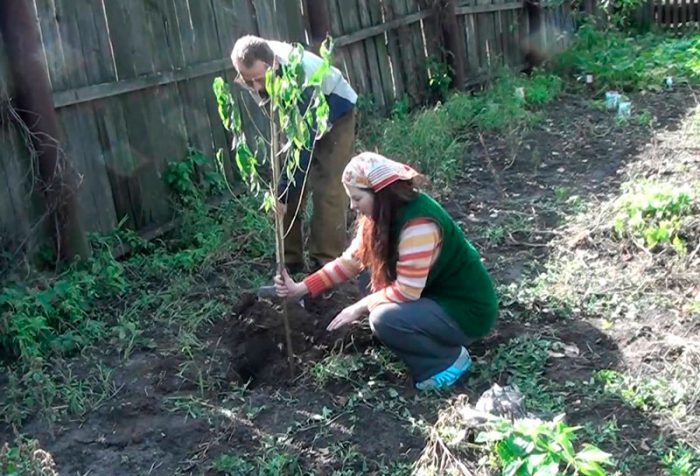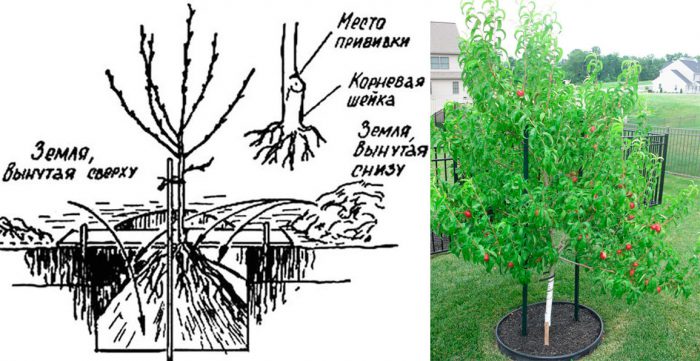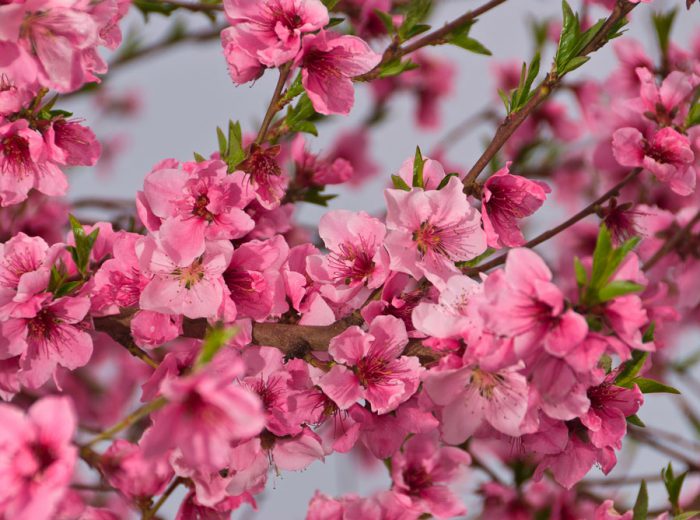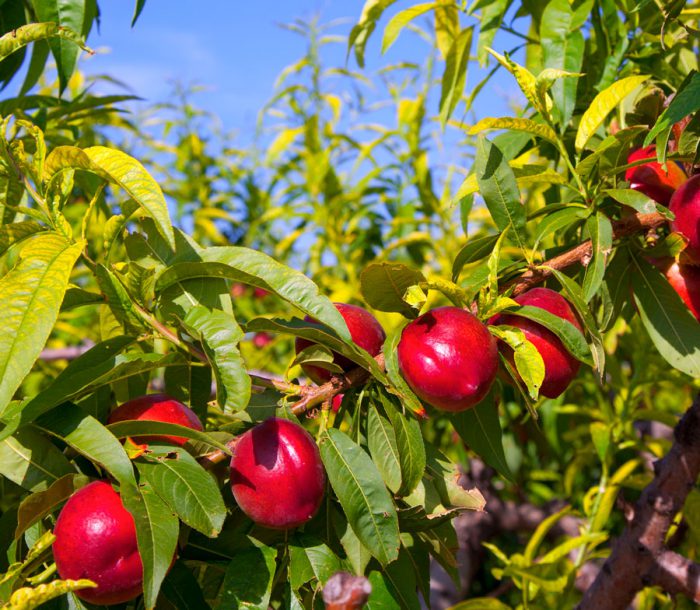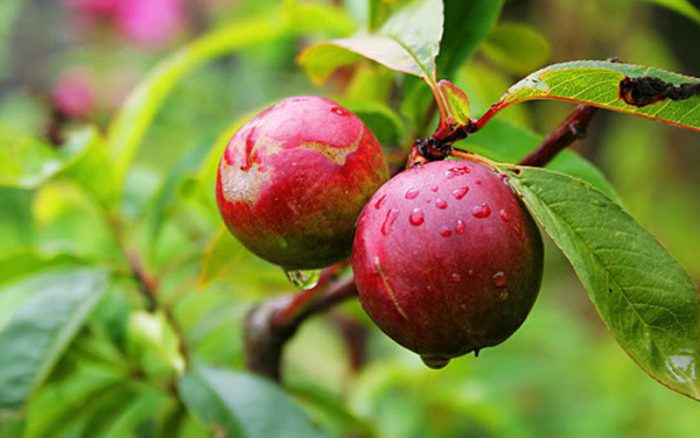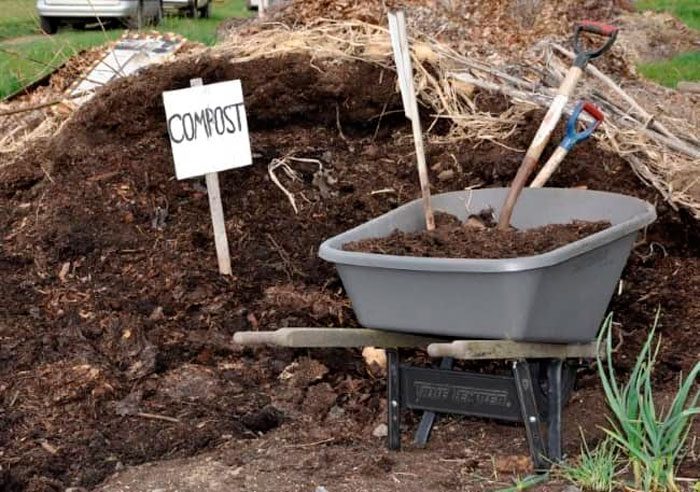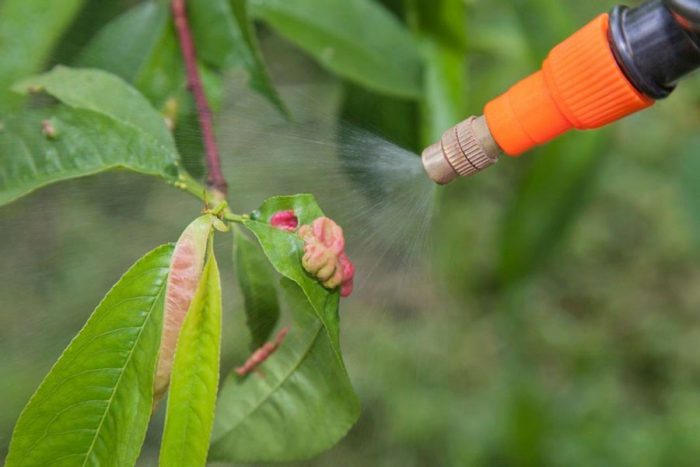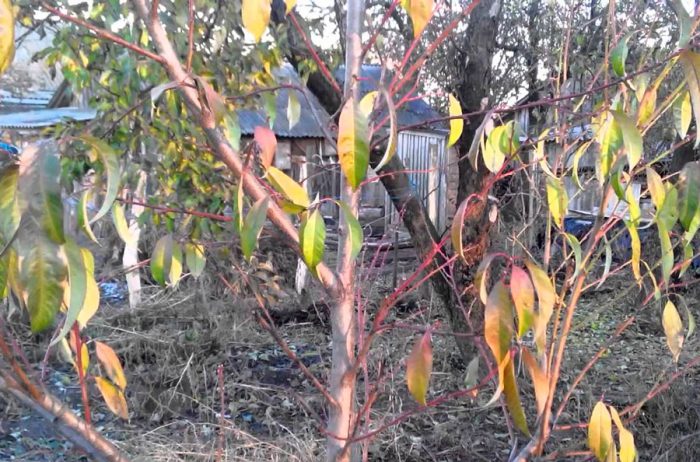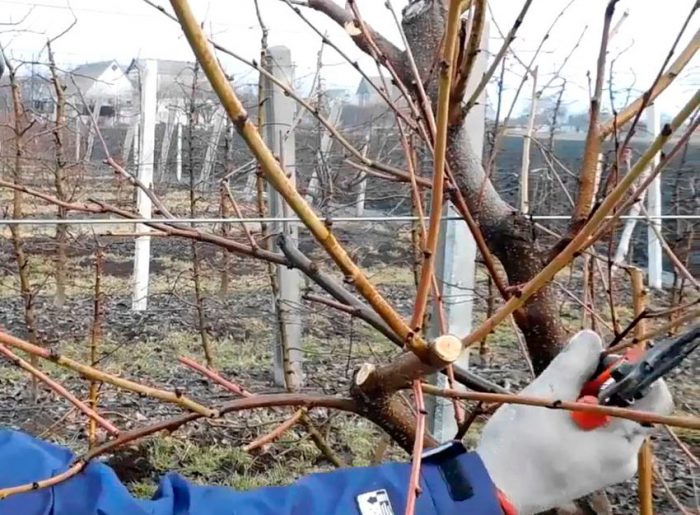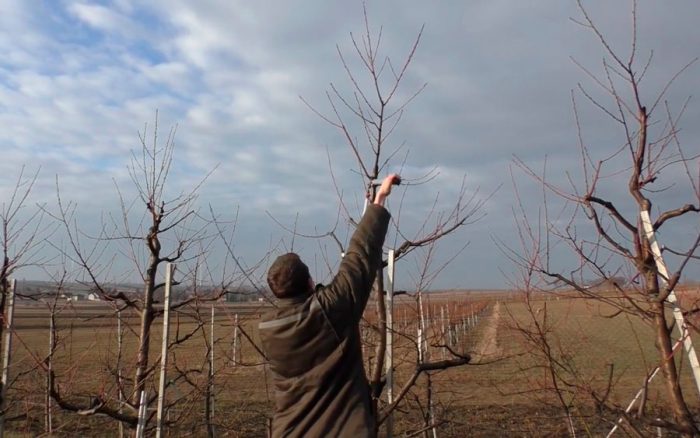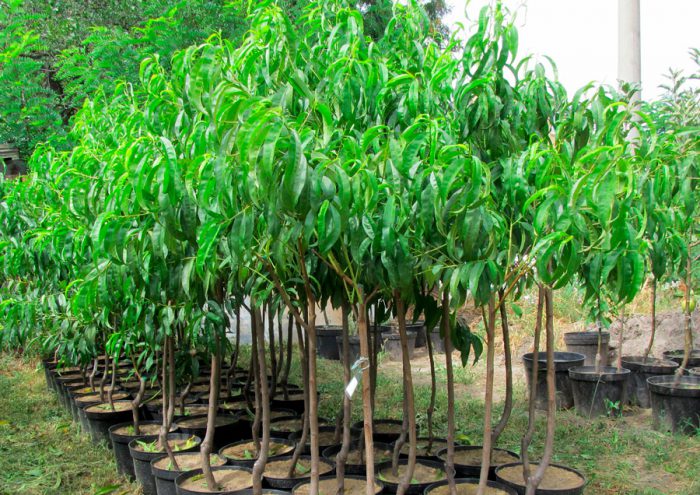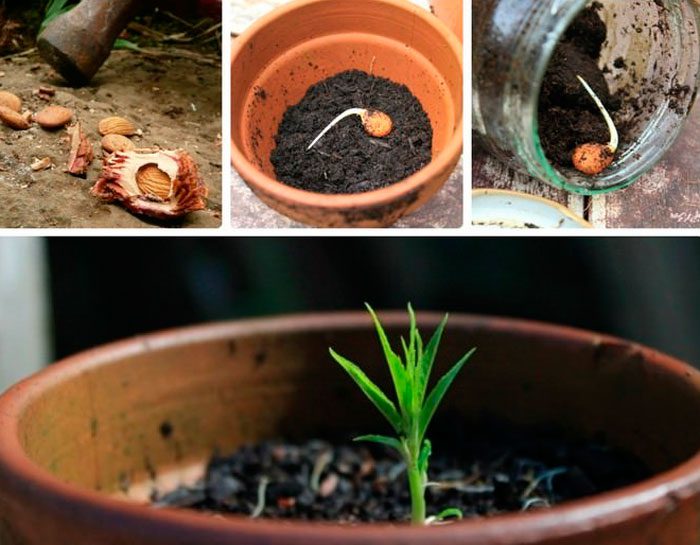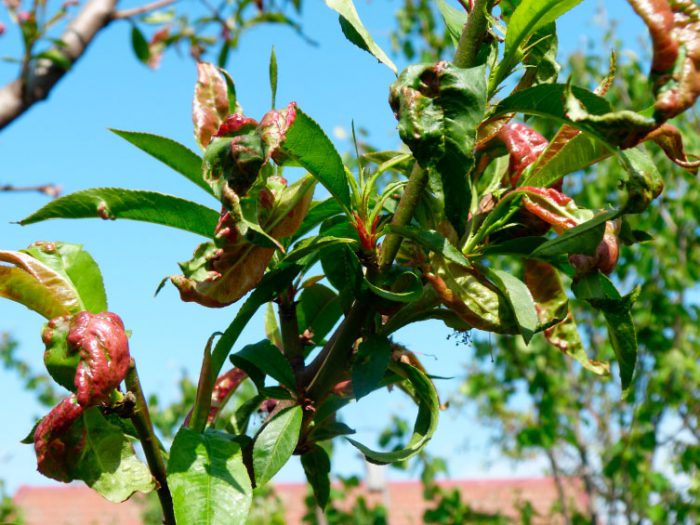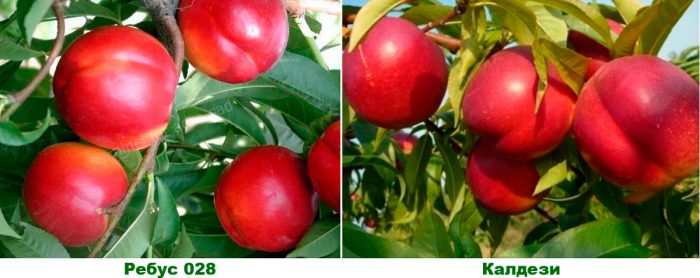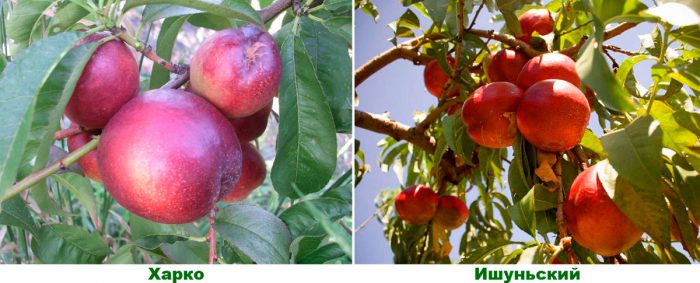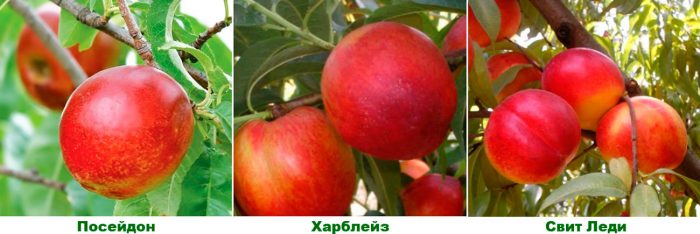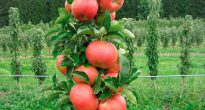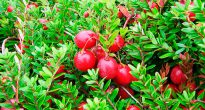Nectarine, also referred to as the bare peach, is a type of peach that has a smooth skin like a plum. In China, this plant has been cultivated for more than 2 thousand years. The earliest description of this culture in Europe dates back to the 14th century. The first mention of nectarine in English-speaking sources was noted in 1616, while in European countries it became popular only in the 20th century and only after large-fruited varieties of such a plant were obtained. Today, the cultivation of this culture on an industrial scale is practiced in the Mediterranean, namely, in Tunisia, Cyprus, Italy, Greece, as well as in the countries of the former Yugoslavia. Compared to peach, nectarine is more resistant to pests and diseases, and frost-resistant varieties of this crop can be cultivated even in the Volgograd region.
To date, scientists do not have a definite answer, how did nectarine come about? Is it the result of the work of breeders or did it come about naturally? It is believed that sometimes nectarines grow on the peach tree and vice versa. In addition, there is an opinion that in addition to the peach, Chinese plum, apricot and almond also participated in the formation of this new culture. In this regard, this plant is a complex interspecific hybrid. The name nectarine comes from the word “nectar” because these fruits contain a large amount of sugar.
Content
Features of nectarine
The height of the nectarine can vary from 4 to 7 meters, while the crown diameter can be equal to 3-4 meters. The sheet plates have a serrated edge. Flowering begins before the leaves grow. The pink-flowered plant looks a lot like a flowering peach tree. The fruits of these two crops are also very similar in size and shape, however, the skin of the nectarine is slippery and smooth, while that of the peach is fleecy. Ripe nectarine fruit can be yellowish, yellow-red, cherry, yellow-green, red-yellow and red.The flesh of the peach is softer than that of the nectarine.
Fruit ripening lasts 3-5 months and at the same time they need warmth. In this regard, this tree is cultivated only in regions with a long and relatively warm summer period. An adult plant is highly frost-resistant, it can withstand frost down to minus 32 degrees, but it should be noted that the death of flower buds is observed already at minus 2 degrees.
In addition to peach, nectarine is considered a relative of the following fruit crops: almonds, plums, quince, apple, pear, apricot, irga, cherry plum, hawthorn, mountain ash, chokeberry, cotoneaster, rose hips and medlar. Nectarine is planted in open ground and looked after in almost the same way as in peach cultivation, but there are still differences.
Planting nectarine outdoors
What time to plant
In more southern regions, it is recommended to plant nectarine outdoors in autumn. If the winter period in the region is frosty, then it is recommended to plant such a culture in the spring. In Crimea and in the southern part of Ukraine, planting of this plant can be carried out both in spring and autumn.
Nectarine grows best on sandy loam and loamy soil, while it cannot be planted on heavy clay soils. Also, for planting it, you cannot choose those areas where the groundwater is shallow, and those places where melons and nightshade crops, clover, alfalfa and strawberries grew not so long ago are not suitable for this purpose, because there is a high probability that the tree can hit verticillosis. It is best for planting this plant to choose a site located on the southern side of the garden plot, while taking into account that it is impossible for the nectarine to be in the shade for more than 1.5-2 hours a day, so there should not be any buildings or other trees. Also, it is not recommended to plant it near a peach, because the risk of being affected by fungal diseases increases, even those that are practically harmless for a peach.
Planting nectarine in autumn
The preparation of the landing pit should be done 15–20 days before disembarkation. The size of the pit should be 0.7x0.7x0.7 m.In the center of the bottom of the pit, a wooden stake should be installed, which should be about 150 cm high.When preparing the pit, the top layer of soil should be thrown aside, then it is combined with 150 grams of superphosphate and with 10 kilograms of rotted compost. ½ part of the resulting soil mixture must be poured into the center of the bottom of the pit so that a slide is obtained.
Experts advise purchasing annual seedlings for planting, while preference should be given to a variety adapted to the climatic conditions of your region. Carry out a thorough inspection of the seedling, as it must be completely healthy. The root system should not have rotten or dried roots, the inside of the bark should be painted green, and there should be no sagging at the grafting site.
A seedling must be installed on the mound, which was poured in the center of the bottom of the pit. When its roots are neatly straightened out, the pit must be filled with the remaining soil mixture. When planting a plant, make sure that the grafting site is 30–40 mm above the surface of the site. Tamp the soil well from the edges of the hole to the center, and then pour 40-50 liters of water into the resulting "hole". After the liquid is completely absorbed, the grafting site should be flush with the soil surface. After that, the tree is tied to a peg, and then it is hilled to a height of 0.2–0.3 m and dry soil is used for this. For the winter, the surface of the trunk circle must be covered with a layer of mulch (compost), the thickness of which should be from 8 to 10 centimeters.
How to plant nectarine in spring
For the spring planting of nectarine, it is recommended to prepare the pit in the autumn.The pit in this case is made and prepared in the same way as during planting in the fall. At the same time, you need to plant a seedling in the spring in the same order as in the fall. However, there is still one difference: during spring planting, the hilling of the seedling is not carried out.


Watch this video on YouTube
Nectarine care
Spring nectarine care
Preventive treatment of nectarine from pests is carried out in mid-April, while the plant is sprayed on the swelling buds with Karbofos. The second spraying of the tree is carried out in the phase of the green cone - this is when the tip of the leaf plate "peeps out" from the bud. For this treatment, a solution of Bordeaux liquid (3%) is used. Formative pruning is done after the buds appear on the plant. After pruning, it will be necessary to perform preventive spraying against pests and fungal diseases, but it should be borne in mind that in this case it is impossible to use products containing copper (for example, Bordeaux mixture). At this time, the use of such remedies for pests as Karbofos and Fozalon is recommended, while they are combined with a drug for fungal diseases, for example, with Cuprozan, Polycarbacin or Benlate. When the plant fades, this treatment is repeated.
After the shedding of the excess ovary ends, it is necessary to normalize the load of the fruits. So, for 10-15 centimeters of the shoot there should be only 1 ovary, and the extra ones must be removed, otherwise, during the period of pouring the fruits, the plant may not withstand their severity.
Summer nectarine care
In the summer, this tree needs watering. Weather conditions affect the frequency and amount of watering. During the summer, nectarine will need 2 or 3 treatments to get rid of the curl of the leaves, for this use Delan's solution or other means of similar action.
During the period of fruit growth, so that they are more sugary and have a rich color, they make several dressings of nectarine on the foliage, using a solution of potassium fertilizer for this. 4 weeks before harvesting, the plant will need abundant watering, as a result of which the size of the fruits can increase by 1/3. However, it should be noted that it is no longer possible to water the nectarine until the harvest.
Nectarine care in autumn
Their frost resistance directly depends on how much water is in the soil during the laying of flower buds. Therefore, when all the fruits are harvested, usually in August-September, the tree should be watered very abundantly.
In the first days of October, before the change in color of the foliage begins, for the prevention of fungal diseases, the plant must be treated with a Bordeaux mixture.
In the last days of October or the first of November, when all the leaves fall off, the area where the nectarine grows should be cleaned. To do this, you need to scoop up all the flying foliage and other plant debris and destroy the fact that various pests could settle in them for the winter. Then water-charging watering of the tree is performed. When the plant is watered, it should be sprayed with copper sulfate against fungal diseases, as well as Nitrafen - to destroy pests that have settled down for the winter in the upper layer of soil under the plant and in its bark.
Watering the nectarine
After the seeds have hardened in the fruit, the nectarine must be watered for the first time. If this procedure is carried out ahead of schedule, the result may be cracking of the fruit. During the growing season, late-ripening and mid-ripening varieties should be watered 4 to 6 times before harvesting, and early-ripening varieties - 2 or 3 times.
To make the fruits more sugary, 4 weeks before harvesting, they arrange abundant watering, depending on the size and age of the plant, 3–6 buckets of water are taken per 1 square meter of the trunk circle. When all the fruits are collected, in the phase of laying flower buds when watering nectarine per 1 square meter of the trunk circle, take from 4 to 7 buckets.
During water recharge irrigation, the soil should be saturated with water to a depth of 0.6–0.8 m. It is at this depth that the lower roots of the plant are located.
Feeding nectarine
If in spring time the tree is sprayed with a solution of urea (7%), then this will not only destroy all pests and pathogenic microorganisms that have wintered in the bark and surface of the trunk circle, but also this substance will become a source of nitrogen for the plant, which it badly needs at this time ... But it should be borne in mind that it is necessary to spray the tree on not yet swollen buds, otherwise they may burn out. In the event that sap flow has already begun, and the treatment with urea has not yet been carried out, then this procedure must be canceled. In this case, it is carried out in the autumn, when all the leaves fall off the plant.
During the growing season, you will need to feed the nectarine by the foliar method 2 or 3 times. For feeding, it is recommended to use the following mixture: for 1 bucket of water, from 50 to 80 grams of ammonium sulfate or ammonium nitrate (can be replaced with 30-50 grams of urea), 10 grams of borax, from 100 to 150 grams of superphosphate water extract, from 30 to 60 grams potassium chloride (or 50–70 grams of potassium sulfate), as well as 15 grams of manganese. If you are feeding the plant when it is in the fruit ripening phase, then remove borax and nitrogen from this nutrient mixture.
If, during the preparation of the pit for planting, you have added all the necessary fertilizers to the soil, then the nectarine will not need nutrients for 5 or 6 years, especially if the surface of the trunk circle is covered every year with a layer of mulch (humus or compost). If the time has come to feed the tree, then it should be remembered that organic fertilizers are applied to the soil once every few years, in the spring time the tree needs nitrogen, and in the summer and autumn - potassium and phosphorus. It is necessary to feed nectarine taking into account the described needs of this culture.
Nectarine processing
For such a fruit tree to always be healthy, it needs systematic preventive spraying from diseases and pests. How to process nectarine through unopened kidneys has been described above. In the green cone phase, the tree is recommended to be treated with a Bordeaux mixture solution (3%).
The next treatment for fungal diseases and pests is carried out in the pink bud phase, while using a combined solution: for 1 bucket of water, 40 grams of Cuprozan or 40 grams of Colicarbacin is taken with the addition of 30 grams of Karbofos or 150 grams of colloidal sulfur. When the tree fades, it will be possible to spray it several more times with a similar composition, if necessary, for example, if harmful insects were found on it, as well as if there are signs of powdery mildew or curly leaves. However, remember that half a month before harvesting the fruits, you need to stop any processing.
When all the leaves fall off the plant, it must be treated with a solution of Bordeaux mixture (3%), which will destroy all pathogenic microorganisms that prefer to winter in the nectarine bark, as well as in the upper layer of its near-stem circle. Then nectarine is sprayed with a solution of Nitrafen (3%) in order to destroy all pests that decide to overwinter on the tree and in the tree trunk circle. One spraying can replace both of these treatments, for which a urea solution (7%) is used.
Wintering nectarine
In the fall, before the onset of frost, it will be necessary to remove fallen leaves and plant residues from the site, carry out water-charging irrigation, feed and process the tree. After that, when the frosts become stable, the surface of the trunk circle will need to be covered with a layer of mulch (tops, sawdust, straw, peat or dried leaves), while it is prepared in advance.In rainy weather, mulching the trunk circle cannot be done, otherwise rot may appear on the root collar, covered with a layer of mulch. Also in autumn it is recommended to whitewash the base of the skeletal branches and the trunk of the plant; for this, lime is used.
Seedlings of autumn planting need shelter for the winter. To do this, it is necessary to install long enough slats on both sides of the seedling. Then a bag of sugar is put on them and on the plant itself. To prevent gusts of wind from tearing off the bag, sprinkle it with soil from below. In the northern part of Ukraine, two and three year old plants will also need shelter. To do this, you need to install 3 long slats around the nectarine, driving them into the ground. At the top, they must be tied using wire for this. When frosts come, the resulting frame must be overlaid with corn stalks or spruce branches, and then wrapped with agrofibre. To prevent this structure from being destroyed by strong gusts of wind, it should be tied with twine. Remember that you should cover the nectarine only after the onset of frost.
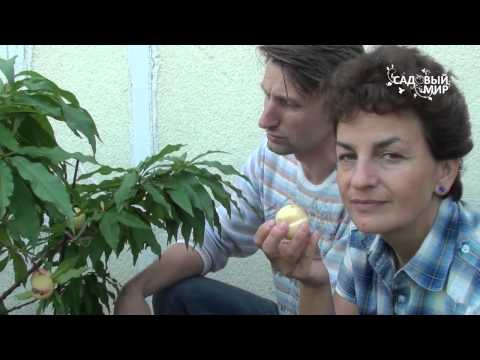

Watch this video on YouTube
Pruning nectarine
What time to trim
Formative pruning is required for nectarine. Fruiting in this plant is observed on annual growths, therefore, during regular pruning, it is very important not only to maintain plant hygiene, but also to ensure intensive growth of annual shoots while avoiding a shift in fruiting to the edge of the crown. It is because of this that it is necessary to annually thin out and shorten the branches of this plant. The first pruning of an autumn planting tree will only be needed with the onset of next spring, before sap flow begins. In spring, young plants need formative and sanitary pruning. In autumn, sanitary pruning of nectarine is carried out only if necessary.
How to trim nectarine
As a rule, the crown of a tree is shaped like a vase or bowl. Thanks to this shape, the crown becomes stronger, and it is also easier to remove fruits from such a plant and easier to care for. Crowns are formed in the spring for the first 4–5 years. First, skeletal branches are laid. In the first year, it is necessary to select 2 or 3 branches with a wide angle of discharge, they are shortened by up to 10 centimeters to the outer buds, while all other branches must be cut out. Each year, 2 or 3 skeletal branches should be added, which should be located at the desired angle. Form a first-order fork on last year's skeletal branches, second-order forks on the year before last, and so on.
During the formation of the crown, the conductor should rise 0.2–0.25 m above the uppermost skeletal branches. After the formation of the crown is over, the conductor must be cut at the level of the upper skeletal branches. The optimum height of the trunk is from 0.5 to 0.6 m. The shoots appearing in the area of the trunk are subject to breaking out, and it is necessary to have time to carry out this procedure before they become lignified. There are gardeners who prefer the stemless form, in which case the skeletal branches can move away from the trunk almost at the very surface of the soil. Such a form contributes to the long-term containment of the growth of nectarine, and it also greatly facilitates the collection of fruits and caring for the tree, since the ladder in this case will not be needed. The recommended height of such a plant is from 250 to 300 cm.
Pruning nectarine in spring
On a pink bud, in April, a formative pruning of nectarine is carried out, as well as a sanitary one, for this they cut out all dried, injured, frost or disease-affected branches. At this time, pruning for fruiting is also carried out, for this, on the skeletal branch, 2 correct developed shoots should be selected that grow side by side.The shoot growing closer to the top of the branch should be shortened by 8–10 buds, it should bear fruit in the current season. Another shoot, located closer to the trunk, must be greatly shortened so that 2 buds remain, a shoot will appear from this replacement knot, which will bear fruit in the next season. What is “correct escape”? This shoot has fruit buds as well as growth (foliage) buds. It is necessary to form a new fruit link from the replacement knot in the next season. In this way, the tree is pruned every year in the spring, as a result of which the yields will be stable and the fruits will be of good quality.
At the end of flowering and dumping excess ovaries, it is necessary to adjust the load of the crop. So, on a branch, for every 10-15 centimeters in length, there should be only 1 fruit, while the extra ovaries must be removed by plucking.
How to prune in summer
If the tree is fruitful, then in the summer it is not pruned. But at this time, they pinch or break out unnecessary stems, this will lead to stimulation of the growth of new branches and to the formation of fruit branches.
How to prune in the fall
When all the leaves have fallen from the tree, sanitary pruning is done if necessary. To do this, cut out all the weak, dried, injured and diseased stems.
Reproduction of nectarine
To reproduce nectarine, two methods are used: seed and generative (grafting). The best results are shown by budding a nectarine scion, while an almond or peach seedling is used as a rootstock. If the site is wet heavy soil, while the groundwater lies close to the surface of the earth, then a cherry plum or home plum sapling is ideal as a stock. It is quite easy to grow nectarine from seeds. However, you should know that a tree grown in this way does not produce very high quality fruits.
How to grow from a seed
Seeds are recommended to be taken from plants adapted to the conditions of your region. To do this, during the fruiting period, go around the neighboring garden plots and take the fruits from those trees that you liked the most. The fruits must be placed in water for 3 days, which is replaced twice a day, then they are removed to a shaded place for drying. After that, the seeds are carefully pulled out of the fruits. For sowing seeds, a well-lit area is chosen, which is located far from buildings and trees. First, you need to make a trench, which is covered with nutritious soil. The bones are buried in it by 50-60 mm, while the distance between them should be equal to 20-25 centimeters. Then the seeds need to be sealed and watered very well. After the liquid is absorbed into the soil, the surface of the garden bed should be covered with a layer of mulch (foliage, grass or sawdust).
Sowing seeds can be done in spring, summer and autumn. If the seeds are sown before winter, then the seeds will undergo natural stratification during the winter months, in spring after the bed is freed from the shelter, seedlings will appear together and start growing.
When seedlings are experiencing intensive growth, make sure that the soil in the garden is always loose and slightly damp. A humus solution is used to feed them. If necessary, they are sprayed from diseases and pests with a solution of Ridomil or Tiovit.
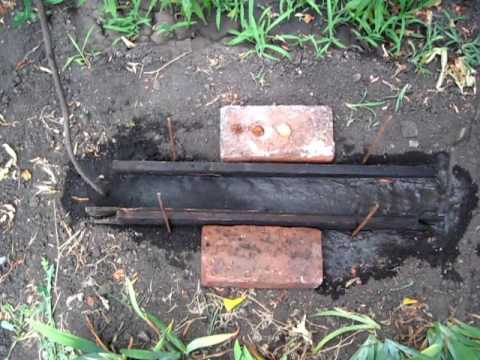

Watch this video on YouTube
Nectarine grafting
Cuttings of this plant are grafted onto almond or peach rootstocks by budding. This method of reproduction is very quick and easy, and its plus is that each fully formed bud is able to give a new plant that will retain all the characteristics of the mother variety. But in order for the vaccination procedure to be successful, you need to adhere to some rules:
- Do not use a stock thinner than a pencil.In this case, keep in mind that the bark at the grafting site should be smooth, thin and elastic.
- The grafting is carried out during the period of intensive sap flow, during this time the bark quite easily lags behind the wood.
- It is necessary that the buds located on the scion are well developed.
- For budding, a very sharp and pre-disinfected instrument is used.
Cuttings for scion are harvested in the morning, at which time the shoots are saturated with moisture. The stalk should be 30 centimeters or more in length, while the leaf plates on it should be developed. Stipules and leaf plates should be cut off, while the petiole remaining after trimming should reach 10 mm in length. Then the lower cut of the cutting is immersed in water.
At the bottom of the rootstock, you need to cut off all existing lateral growths. All dirt and dust should be removed from the stem. To do this, take a clean damp cloth and wipe the stem, moving from the root collar upwards by 20 centimeters. Then, in the place where the stock was free of dust, it is necessary to make a T-shaped cut in the bark. In doing so, try not to damage the wood. The length of the transverse incision should be 15 mm, then a perpendicular incision is made from its middle downwards, reaching a length of 25 to 30 mm. Where the 2 incisions are connected, it is necessary to carefully unscrew the corners of the bark to the width of the transverse incision.
Take the handle with your left hand, with the top facing you. Next, a small (1.2–1.3 cm long) transverse incision is made on its cortex, while it must pass below the kidney that will be used for transplantation. A similar transverse incision of the same length must be made above this kidney. You need to start cutting off the bark with the kidney from the upper incision, while smoothly moving towards the lower one. The resulting shield should be about 25 mm long, flexible, and the kidney intact.
Use your thumb and forefinger to grasp the remainder of the stem, then gently place it under the folded bark of the T-shaped incision made in the rootstock. In the event that the length of the shield turns out to be longer than necessary, then it is necessary to carefully cut off the excess along the border of the transverse cut on the rootstock. Using your thumb, press the bark firmly along the longitudinal cut against the flap under the bark. Then take a polyethylene tape and wrap it around the vaccination site, moving from top to bottom.
After half a month, you need to check whether the budding was successful. To do this, lightly touch the remainder of the petiole, if everything went well, then it should separate and fall off.
Diseases of nectarine
Peach and nectarine affect the same diseases. Most often, nectarine can affect clasterosporium, leaf curl, powdery mildew, fruit rot, stone fruit moniliosis, or gray fruit rot, cytosporosis, verticilliasis, coccomycosis, scab, milky shine and fungal burn.
If you provide the plant with proper care, as well as adhere to all the rules of agricultural technology of this crop and systematically carry out treatments in order to prevent diseases and pests, then your tree may not get sick. If the nectarine does get sick, then you need to remember that mycoplasma and viral diseases today are considered incurable, and therefore the affected specimen must be removed from the ground and destroyed. In the fight against fungal diseases, the following remedies are most popular: Horus, Vectra, Skor, Topsin M, Topaz and Strobi. It should also be remembered that the signs of diseases and the order of their treatment in nectarine are exactly the same as in peach.
Nectarine pests
Nectarine and peach also have pests in common, which also need to be dealt with using the same methods. Most often, these cultures are affected by the eastern and plum moths, aphids, scale insects, striped, miner and fruit moths, flower-eating weevils and ticks.
Pests are fought with the help of insecticidal agents, for example, you can use drugs such as: Chlorofos, Zolon, Karbofos, Aktara, Mospilan, Aktellik, Inta-vir, Bankol, Metaphos and Durban.
Nectarine varieties with photos and descriptions
Early maturing varieties
The most popular among gardeners are the following early maturing nectarine varieties:
- Fleming Fury... This super-early variety was created by breeders from America. Large fruits are almost completely covered with a blush of red color. The yellow flesh is quite tender.
- Big Top... This ultra-early variety, created in America, is distinguished by its unpretentiousness and high yield. The fruits have a bright purple-cherry color and a round shape, they weigh about 200 grams. The pulp is firm, juicy and yellow; closer to the stone, it acquires a red tint. The sweet pulp has a honey flavor and a slight sourness. The bone is difficult to separate from the pulp.
- Ruby 4... This early-growing variety was created by Ukrainian breeders, it is distinguished by its yield. Large oval-shaped fruits are covered with glossy skin and weigh about 200 grams. The pulp is juicy, delicately fibrous, it is colored yellow with a pale red tint. The taste of the pulp is sweet with a barely noticeable sourness. The bone is difficult to separate from the pulp. The fruits tolerate transportation well enough.
- Rebus 028... The early-growing variety, created by Italian breeders, is distinguished by its yield and resistance to diseases and frost. The shape of large fruits is round, slightly elongated, they weigh about 200 grams. The fruit has a yellow color, while almost all of its surface is a deep red blush. Juicy dense fragrant pulp has a yellow color and a sweet taste.
- Caldesi... The variety of Italian selection has a high yield. Almost the entire surface of large spherical fruits of a yellow-green color is covered with a marble rich red blush. Juicy dense pulp is white in color. Semi-detachable bone.
Mid-season varieties
The most popular mid-season nectarines are:
- Stark Red Gold... This variety, created in America, has a high yield. Large carmine red fruits are regular in shape, weighing about 240 grams or more. The slightly fibrous dense pulp has a rich yellow color, and near the stone it becomes reddish. The pulp can be easily separated from the seed.
- Wang-3... This early-growing variety, created by American specialists, is distinguished by its yield and resistance to frost and disease. The shape of the fruits is round, their color is deep red with light yellow fragments, weighing about 220 grams. The cartilaginous yellow flesh has a high taste.
- Alitop... This variety, created in Italy, has a high yield. Large fruits of an oblong-rounded shape weigh about 250 grams, almost their entire surface is occupied by a deep red blush. Juicy dense fragrant pulp has a yellow color with streaks of red, it has a high taste.
- Harko... The variety, created by Canadian breeders, has a high yield and resistance to frost and disease. On almost the entire surface of not very large yellow-green rounded fruits, there is a purple-red blush. Fleshy juicy pulp has a yellow color and sweet taste with a slight sourness. The bone is easily separated from the pulp.
- Ishunsky... This variety was created by Ukrainian breeders. On not very large yellow fruits, there is a carmine blush, they weigh about 150 grams. The delicate, fibrous, juicy pulp is yellow in color with red veins. The pulp from the bone can be easily separated.
Late-ripening varieties
The most popular late ripening varieties:
- Poseidon... A variety of domestic selection.The universal fruits are round and yellow in color with a not very large carmine blush arranged in the form of strokes. The juicy, yellow fibrous pulp has a small amount of red veins. The pulp is easily separated from the bone.
- Harblaze... This variety is dessert. Almost the entire surface of the yellow oval fruits is covered with a deep red blush. The very juicy flesh has a yellow color and a sweet-sour taste. The pulp can be easily separated from the stone.
- Sweet Lady... The variety, created by Italian breeders, is distinguished by its yield and resistance to diseases. Large yellow fruits have a deep red blush and weigh about 300 grams or more. The yellow firm, dense pulp has an excellent taste. The pulp can be easily separated from the stone.
- September Queen... The blush on pale green fruits is dark red. The creamy dense fragrant pulp has a sweet-sour, very pleasant taste. The stone separates well from the pulp.
- Evpatoria... This self-fertile variety was created in the Nikitsky Botanical Garden. It is recommended to cultivate it in Ukraine, Krasnodar Territory, Transcaucasia and Moldova. Yellow fruits are covered with a carmine blush by ¼ – 1/2 part. The juicy fibrous pulp has a yellow color and red veins; it has a pinkish tint near the stone. The pulp from the bone can be easily separated.
Still quite popular varieties of nectarine are such as: Nikitsky 85, NIC 19, Flavor Top, Kolonovidny, Krimzon Gold, Krymchanin, etc.


Watch this video on YouTube

